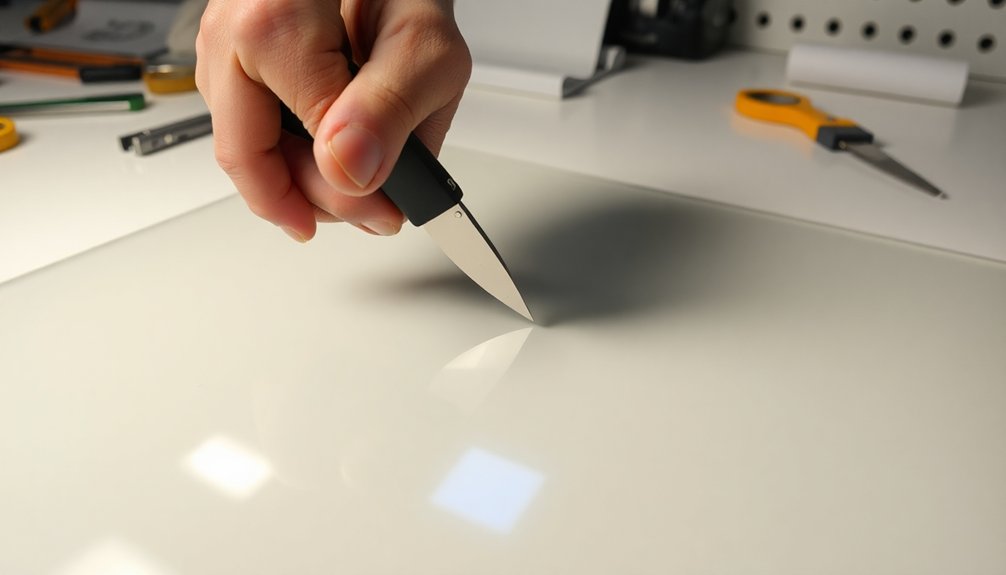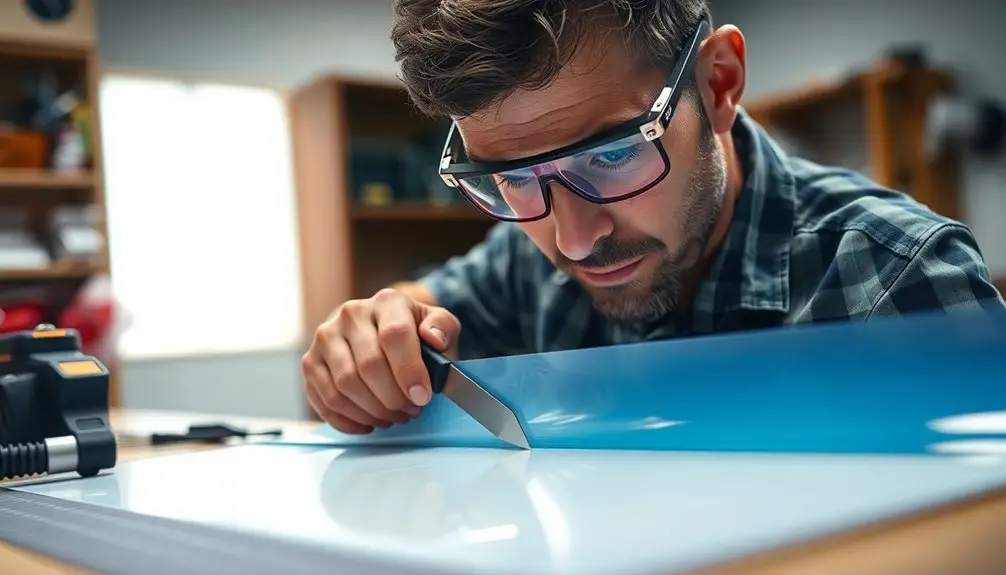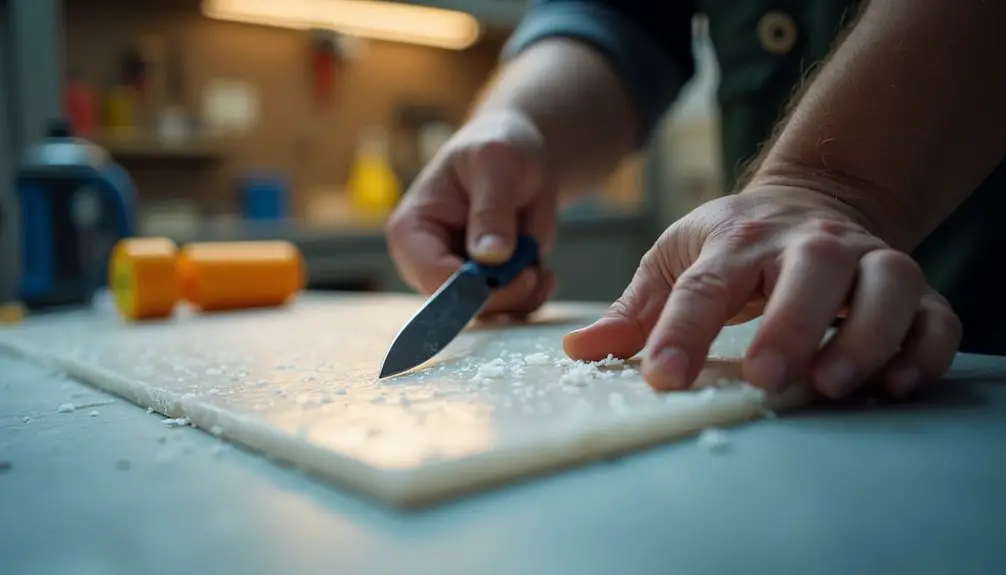To cut polypropylene safely and effectively, you'll need to choose the right tools and techniques. A circular saw with plastic blades is great for straight cuts, while a handheld jigsaw works best for thinner sheets with intricate shapes. Always maintain a slow feed speed to reduce melting and kickback. Wear safety goggles and gloves for protection, and keep your workspace tidy. Don't forget to check your tools regularly for maintenance. By following these guidelines, you can achieve clean cuts and ensure your safety. If you want to uncover more tips on this topic, keep on exploring.
Key Takeaways
- Use a circular saw with special plastic blades for smooth, straight cuts while minimizing melting.
- Maintain slow blade and feed speeds to reduce heat buildup during cutting processes.
- Wear appropriate PPE, like safety goggles and gloves, to protect against debris and tools.
- Ensure proper ventilation when using heat tools to avoid inhalation of harmful fumes.
- Regularly inspect and maintain cutting tools to ensure optimal performance and safety.
Understanding Polypropylene Properties
Understanding the properties of polypropylene is crucial for anyone looking to utilize this versatile material effectively. This lightweight thermoplastic is known for its chemical and moisture resistance, making it ideal for applications ranging from packaging to automotive parts.
However, when you're considering injection molding or other methods of shaping polypropylene, you should be aware of its limitations. Polypropylene has a high thermal expansion coefficient, which means it can warp or degrade in high-temperature environments. Additionally, it exhibits poor resistance to UV degradation and oxidation, so if you plan to use it outdoors, protective measures are necessary.
You also need to be cautious about its flammability and bonding properties; specific adhesives or coatings are often required for effective attachment.
On the upside, polypropylene is recyclable and increasingly favored for sustainability initiatives due to its durability and non-toxic nature. By thoroughly understanding polypropylene properties, you can make informed decisions that lead to successful outcomes in your projects.
Whether you're cutting, molding, or assembling, knowing these characteristics will enhance your ability to work with this adaptable material. When choosing an alternative material, the difference between LDPE and HDPE should also be considered, as these polyethylene types exhibit distinct properties for various applications.
Essential Cutting Tools
When it comes to cutting polypropylene, choosing the right tools can make all the difference in achieving clean, precise cuts. Here are three essential cutting tools you should consider:
- Circular Saw: If you need to make straight cuts in polypropylene sheets, a circular saw equipped with special plastic saw blades, like the Tenryu Plasti-Cut, is your best bet. This tool ensures smooth edges and reduces the risk of melting.
- Handheld Jigsaw: For thinner sheets, a handheld jigsaw with metal cutting blades works wonders. It allows you to create intricate shapes and curves, giving you the flexibility needed for detailed projects.
- Sabre Saw: When tackling thicker sections, a sabre saw using coarse wood blades provides satisfactory results. It minimizes heat generation, which helps prevent melting during the cutting process.
Effective Cutting Techniques

To achieve the best results when cutting polypropylene, it's essential to employ effective techniques that minimize heat generation and ensure clean edges.
Start by using a circular saw equipped with special plastic saw blades, like the Tenryu Plasti-Cut. This setup allows you to make straight cuts while minimizing the risk of melting. Maintain a slow blade and feed speed to further reduce heat buildup, preventing warping or melting during the process.
For more intricate shapes or curves, a handheld jigsaw works well with a metal cutting blade. Remember to keep your pace slow for better control, which will help you achieve smoother edges.
After cutting, consider using a heat welder to seal seams, enhancing both the finish and structural integrity of your polypropylene sheets. It's crucial to identify the plastic type compatibility before attempting to weld, as this affects the quality of the weld.
When using power saws, always be mindful of kickback. Keep your workspace clear to avoid accidents, and don't forget to wear proper eye protection.
Safety Measures and Precautions
Cutting polypropylene involves inherent risks, so taking proper safety measures is crucial. You want to ensure you're protecting yourself and your workspace while minimizing the chances of accidents.
Here are three essential safety measures to follow:
- Wear Personal Protective Equipment (PPE): Always put on safety goggles and gloves to shield your eyes and hands from sharp tools and debris.
- Maintain a Clean Workspace: Keep your cutting area clear of obstructions and distractions. A tidy environment reduces the risk of accidents and allows you to focus on the task at hand.
- Proper Ventilation: If you're using heat tools, make sure your workspace is well-ventilated. This helps prevent inhalation of fumes and maintains air quality, ensuring your safety while cutting. Always follow the manufacturer's instructions for all cutting tools to guarantee safe operation.
Additionally, regularly inspect and maintain your tools to ensure they're in good working condition. Working in a well-ventilated area can be especially important when working with plastics, such as polycarbonate, which can release toxic fumes when heated.
Maintenance and Aftercare

Maintaining polypropylene is essential for ensuring its longevity and performance. To keep your polypropylene surfaces looking great and functioning well, regularly clean them with mild soap and water. This simple maintenance step helps prevent degradation from harsh chemicals. For tougher stains or grime buildup, consider using DIY Cleaning Solutions specifically designed for plastic furniture.
When storing polypropylene sheets, choose a cool, dry place to avoid warping and extend the material's lifespan.
It's also crucial to inspect your polypropylene items periodically, especially after heavy use. Look for any signs of wear or damage; catching potential issues early can save you from costly replacements. If you find any damaged products, consider recycling or repurposing them to minimize waste and support sustainability efforts.
Don't forget about the tools you use for cutting polypropylene. Regular maintenance of your cutting tools is vital; check and sharpen blades frequently to ensure safe and effective operation.
Frequently Asked Questions
What Is the Best Way to Cut Polypropylene?
To cut polypropylene effectively, use a circular saw with plastic-specific blades. For curves, opt for a jigsaw at a slower speed. Always keep your blades sharp and prioritize safety by wearing protective gear.
What Is the Best Way to Cut Poly Plastic?
To cut poly plastic effectively, use a sharp circular saw or jigsaw. Maintain slow speeds to prevent melting, and always practice on scrap pieces first. This ensures clean, precise cuts without damaging the material.
Can You Cut Polypropylene With a Saw?
Yes, you can cut polypropylene with a saw. Use a circular saw for straight cuts or a jigsaw for curves. Just make sure you've got sharp blades and take precautions to avoid melting and chips.
Can You Cut Polypropylene With a CO2 Laser?
Yes, you can cut polypropylene with a CO2 laser. It offers precision and can seal edges, reducing fraying. Just ensure you adjust the settings properly and use adequate ventilation for safety during the process.

